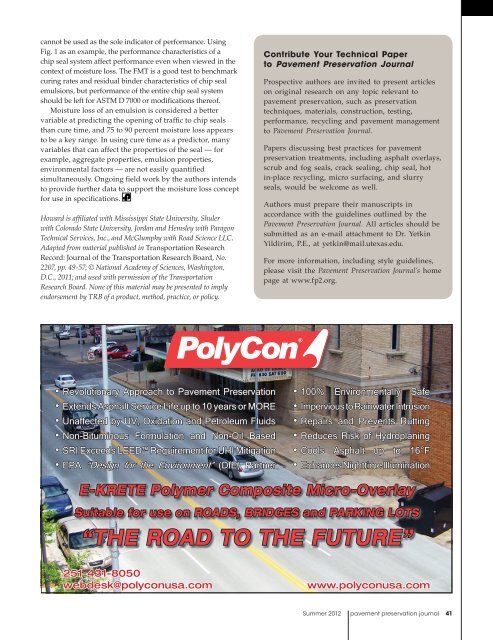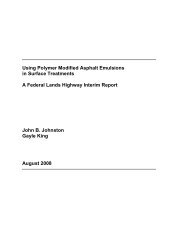journal - TSP2
journal - TSP2
journal - TSP2
You also want an ePaper? Increase the reach of your titles
YUMPU automatically turns print PDFs into web optimized ePapers that Google loves.
cannot be used as the sole indicator of performance. Using<br />
Fig. 1 as an example, the performance characteristics of a<br />
chip seal system affect performance even when viewed in the<br />
context of moisture loss. The FMT is a good test to benchmark<br />
curing rates and residual binder characteristics of chip seal<br />
emulsions, but performance of the entire chip seal system<br />
should be left for ASTM D 7000 or modifications thereof.<br />
Moisture loss of an emulsion is considered a better<br />
variable at predicting the opening of traffic to chip seals<br />
than cure time, and 75 to 90 percent moisture loss appears<br />
to be a key range. In using cure time as a predictor, many<br />
variables that can affect the properties of the seal — for<br />
example, aggregate properties, emulsion properties,<br />
environmental factors — are not easily quantified<br />
simultaneously. Ongoing field work by the authors intends<br />
to provide further data to support the moisture loss concept<br />
for use in specifications.<br />
Howard is affiliated with Mississippi State University, Shuler<br />
with Colorado State University, Jordan and Hemsley with Paragon<br />
Technical Services, Inc., and McGlumphy with Road Science LLC.<br />
Adapted from material published in Transportation Research<br />
Record: Journal of the Transportation Research Board, No.<br />
2207, pp. 49-57; © National Academy of Sciences, Washington,<br />
D.C., 2011; and used with permission of the Transportation<br />
Research Board. None of this material may be presented to imply<br />
endorsement by TRB of a product, method, practice, or policy.<br />
Contribute Your Technical Paper<br />
to Pavement Preservation Journal<br />
Prospective authors are invited to present articles<br />
on original research on any topic relevant to<br />
pavement preservation, such as preservation<br />
techniques, materials, construction, testing,<br />
performance, recycling and pavement management<br />
to Pavement Preservation Journal.<br />
Papers discussing best practices for pavement<br />
preservation treatments, including asphalt overlays,<br />
scrub and fog seals, crack sealing, chip seal, hot<br />
in-place recycling, micro surfacing, and slurry<br />
seals, would be welcome as well.<br />
Authors must prepare their manuscripts in<br />
accordance with the guidelines outlined by the<br />
Pavement Preservation Journal. All articles should be<br />
submitted as an e-mail attachment to Dr. Yetkin<br />
Yildirim, P.E., at yetkin@mail.utexas.edu.<br />
For more information, including style guidelines,<br />
please visit the Pavement Preservation Journal’s home<br />
page at www.fp2.org.<br />
<br />
<br />
<br />
<br />
<br />
<br />
<br />
<br />
<br />
<br />
<br />
<br />
E-KRETE Polymer Composite Micro-Overlay<br />
Suitable for use on ROADS, BRIDGES and PARKING LOTS<br />
“THE ROAD TO THE FUTURE”<br />
251-431-8050<br />
webdesk@polyconusa.com<br />
www.polyconusa.com<br />
569332_PolyCon.indd 1<br />
Summer 2012 pavement preservation 1/19/12 <strong>journal</strong> 5:20:18 PM41
















